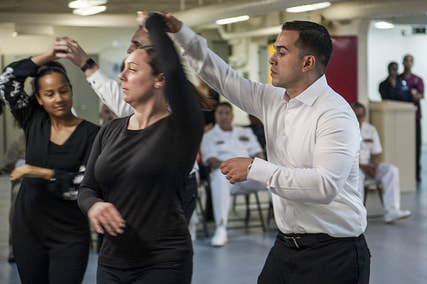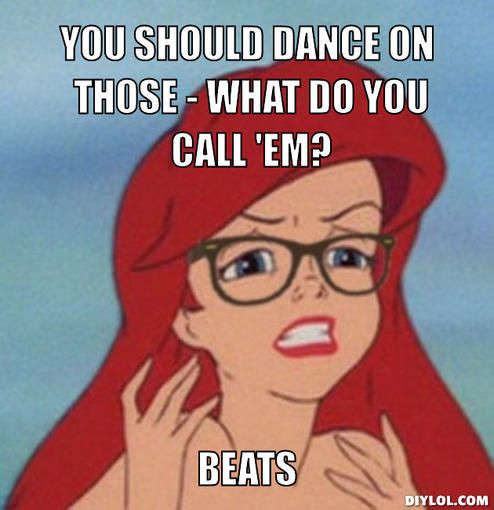|
When students are looking for a place to learn dance, or perhaps even a new place to learn, they will often want to know that they are being taught the proper way to dance. This raises the question: What is proper dance? Different people will use different ideas to determine if the dance being taught is proper. Let's consider some. Traditional If you can find the way the dance was danced in its home country and at the time it was conceived, then surely that must be the proper way to dance it. This is an approach that is often used in the less formalised dances such as swing and street Latin. However, it is often hard to determine the period in history that would be considered the time the dance was proper. Further, even if you go to the originating country, you will find that people there would dance it differently depending upon the part of that country they are from. Even different parts of Buenos Aires exhibit different styles of tango so travelling to Argentina will not allow you to be certain you are dancing proper tango. Standardised dances Dances such as Waltz, Samba, cha cha, Foxtrot, Jive and quickstep have been codified by international dance organisations. This standardisation and agreement by the respective committees lends some authority to the standardisation. One could consider these to be proper. However, these dances are the standardisation of other dances that had already been developed by other communities. Further, sometimes the standardisation would be performed by people who were unfamiliar with the culture that originated the dance. The end effect was that the dance that came about was a corruption of the original. It is hard to argue that this is proper. Dance sport Dance sport dance has much in common with the standardised dances. It is often those standards that are used for judging. However, dance sport does allow for evolution. If you watch videos from dance sport competitions from decades in the past, then you will see a marked difference in the nature of the dance. This continued evolution of better dance in the crucible of competition would produce a better dance that would at least be getting close to something one could call proper. The thing is that dance sport had its origins within the working-class dancers who wanted to be evaluated and compared to each other. The dancers of aristocracy danced for pleasure and to show civility. You could possibly imagine how an aristocrat might respond to the notion of being judged by another on how well they danced and compared to others: not well! These are two competing views of dance and both seem valid (one to dance to the best of precision and be the best there it and the other to dance for the cultural, social and pleasurable benefits that come with it). It is thus hard to argue that we have found an avenue to proper dance. Each of the above ideas has provided some ideas on what proper dance is. However, flaws can also be found in each. The same would likely be true of any other idea put forward on what makes for proper dance. If none of the above (or other) ideas can provide complete insight into what proper dance is, then what are we to conclude? It probably means that the question is not well formed. Or, that it assumes that dance is the type of thing that can be described as proper. If we take a moment to compare what dance is, then we can reformulate the question, and students can then find a way to evaluate a dance school or studio. What do we know about dance? The following is probably hard to argue with:
So when you are looking for a dance studio, ask about how they can help you explore dance so you can get what you want.
10 Comments
When it comes to dance, some of us already know musical theory, some of us can simply intuit the beat, some can express the emotion and some simply have no idea at all. No matter your level of musicality (or how much you think you have or do not have) you can dance, but there is probably also room for improvement. This blog will talk about the basics of musicality and how you can use it to make you dance better. Do you need to know how to count music? This is a common question. There are people who can ‘feel’ the music and have a sense of when to step to stay in time. However, some dances, when they are taken to a higher level (and actually some from the get go) require you to know where you are relative to specific beat to dance well. That means being in time with the beat, while essential, is not enough. You need to know which beat it is. That means you need to start counting. Depending upon the music you might need to count to 8 and you might also need to count the bars (more about that later). What to do if you seriously have no idea? Not exactly sure what people mean when they say ‘beat’ or ‘bar’? Can’t work out what people are actually counting when they are counting music? You’re not alone. However, this should also not stop you from dancing. It simply means you need a crash course in music. Fortunately, that is fairly easy to do:
What is musical appreciation and how to use it? Musical appreciation can be taken to considerable length. However, for dance the following is like what will serve you best:
Then when you are dancing:
Note: do not let your expression interfere with how you lead or follow. Some people get into the music so much that they forget their partner. Key musical terms for better musicality There was mention already of beats and bars above. However, it is worth going over these in more detail and noting some other features of music for you to be aware of:
Other things to note
When you become better at musicality, you might find that you simply do not wish to dance some figures to some music; they just won’t fit. It can at times be hard to identify individual instruments. Watching a band play so that you can start to link the sound to the instrument can help. If you want to get a link between the audio and the visuals of music, then try Jam Studio. It let’s you make music and shows you’re the beats as they are played. That can help you hear them. It can be worth finding sheet music to see what the music is meant to be. I know of waltzes that were actually 9 beats to the bar, but everyone thought it was a 3 beats to the bar song. You could still waltz to it, but knowing it was 9 beats to the bar meant that one knew the phrasing would be different. Many songs you might want to dance to can be found on Chordify, which will play the music and show you the beats in the musical score at the same time. This can also help find the beats in the music This topic has been covered to an extent on this page; however, it is such an interesting topic that it deserves attention here as well. There are 4 aspects to dance helping you:
PhysicalityDance is not the most strenuous of activities. However, it does demand complex movement and good posture. By simply working on moving well as you dance and maintaining good posture, you will increase your mobility and strength of the muscles you use to move. The end effect is a healthier body that moves with ease. CognitiveDance is surprisingly good for your brain. When you dance you need to listen to the music, be aware of your partner, be aware of others on the floor and move your body. These actions all use different parts of your brain. Because these different parts are working in parallel, it is excellent brain exercise. This is why dance is so good at fighting dementia. AttitudinalMany people make the comment that after a night of dancing they are alert, and need time to wind down before bed. Dance simply makes you feel good. The combination of physical and mental stimulation it offers leaves one feeling much better. Dance will make you a happier person. SocialWe are talking about partner dance here. That means it is at least you and another person. Thus it is social from the get go. However, you often learn in groups, you will likely dance with a number of people in a night and you simply start talking with those around you. Dance will provide you with many social connections, and leave you a happier person for that reason.
|
AuthorThis blog is written by the staff at Destine Dance and is inspired by the questions and challenges faced by our students Archives
July 2024
Categories
All
|


 RSS Feed
RSS Feed